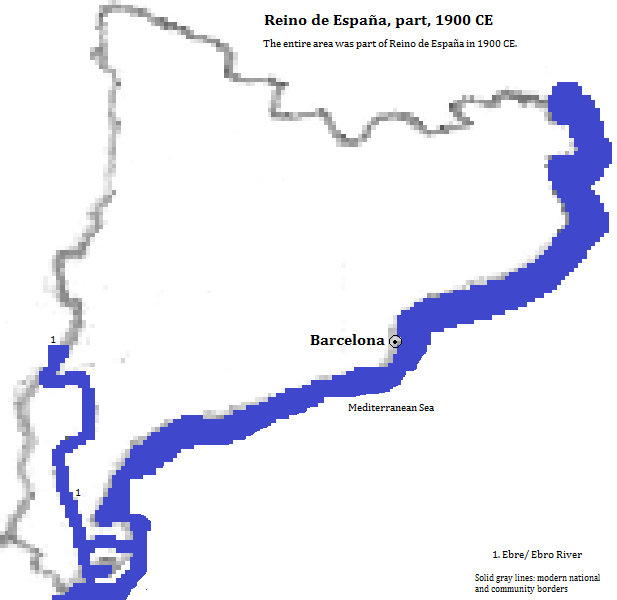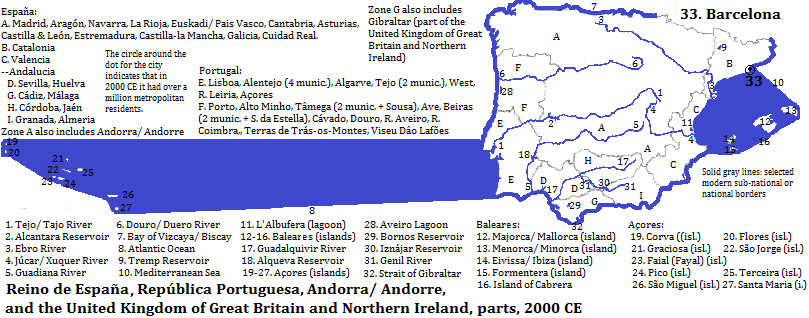Barcelona
The second largest city in Iberia is Barcelona on the northeast coast, in its eponymous province in the center of the Catalonia Autonomous Community of España (Spain). It is bounded north and south by the Besòs and Llobegrat rivers, and west by low mountains. Over 5.4 million live in the metropolitan area,1 1.6 million in the city itself.2 Its population grew to greatness as a result of the Industrial Revolution.
The tallest structure is a telecommunications tower, the Torre de Collserola at 945 feet with an observation deck at 445 feet (1992). El Temple de Sagrada Familia Church, under construction since 1882, is 558 feet tall and was architected by Antoni Gaudí.3 His work on the Christian Nativity facade and on the crypt are honored by UNESCO as part of a World Heritage Site. The tallest conventional skyscrapers are the Hotel Arts Barcelona and the Torre (tower) Mapfre (both 505 feet, 1992). Another famous modern building is the Torre Agbar; its brise-soleil includes electricity-generating panels. Among the monuments is one to Cristóbal Colón (Cristoforo Colombo, Christopher Columbus); the statue ways 42 tons. Another is the Font Mágica (Magic Fountain, 1929). Others of Gaudí's efforts that are included in the UNESCO site are: la Pedrera (or Casa Milà, 1910); Casa Batlló (1906); Casa Vicens; the Park Güell, the Palacio Güell; and the Colonia Güell. Another famous architect is Lluis Doménech i Montaner, known for the Palau de la Música Catalana (Palace of Catalonian Music, 1908) and the Hospital de Sant Pau (finished in 1930), whose modernist architecture he thought would assist the convalescing. These two together constitute a UNESCO World Heritage Site. The city's Gothic quarter includes a cathedral, started in the 13th century but only completed in the 19th.4
The metropolis is served by the Barcelona-El Prat airport, in El Prat de Llobregat, a city of nearly 63 thousand located on the delta of the Llobregat River.5
The city includes one of the world's important commodity ports.6
| Year | Population | Political entity |
| 1900 CE | 552,0001 | Reino de Espaņa (Kingdom of Spain) |
| 2014 CE | 5,400,0007 | Reino de Espaņa (Kingdom of Spain) |
External references
Overview of Barcelona that includes the El Temple de Sagrada Familia Church, Barcelona Province, Catalonia (Catalunya) Autonomous Community, España (Spain)
Historical maps


Footnotes
1. Eurostat Larger urban zone (2014) column of https://en.wikipedia.org/wiki/List_of_metropolitan_areas_in_Europe, accessed December 28, 2015.
2. 2015 figure from the side bar of https://en.wikipedia.org/wiki/Barcelona, accessed 4/12/2016.
3. It is also a major tourist attraction: www.touropia.com/tourist_attractions_in_Spain/, accessed Dec. 30, 2015.
4. Information about most buildings is from emporis.com, accessed 4/12/2016. Information about the World Heritage Sites is from UNESCO, World Heritage Sites (Firefly Books, 2010).
5. The airport is one of the nation's busiest (criterion: over 10 million passengers according to the 2014 table in List_of_busiest_airports_in_Spain, accessed 12/30/2015). The city's 2014 population is from the side bar of https://en.wikipedia.org/wiki/El_Prat_de_Llobregat, accessed 12/28-30/2015.
6. The Times Atlas of the Oceans (Van Nostrand Reinhold Company, 1983), "commodity loading ports" map.
7. Estimate in Tables of the World's Largest Cities, in Tertius Chandler, Four Thousand Years of Urban Growth, 2nd ed. (The Edwin Mellen Press, 1987). It was the largest city in the Iberian peninsula in 1900 CE.


